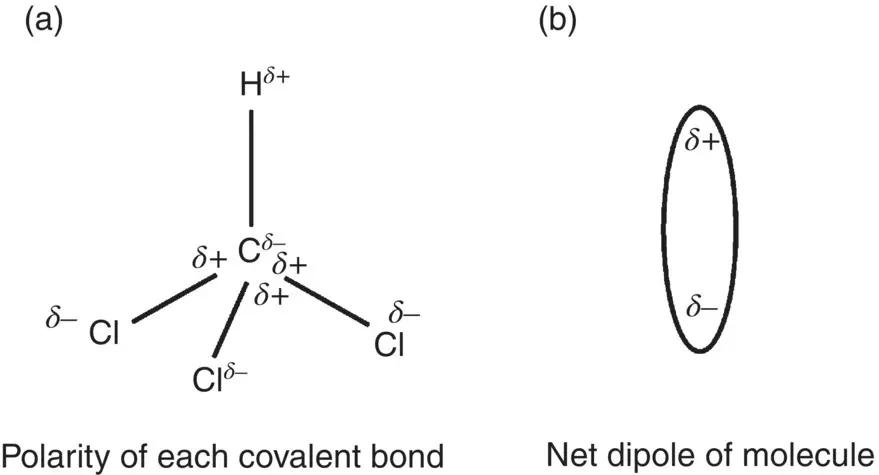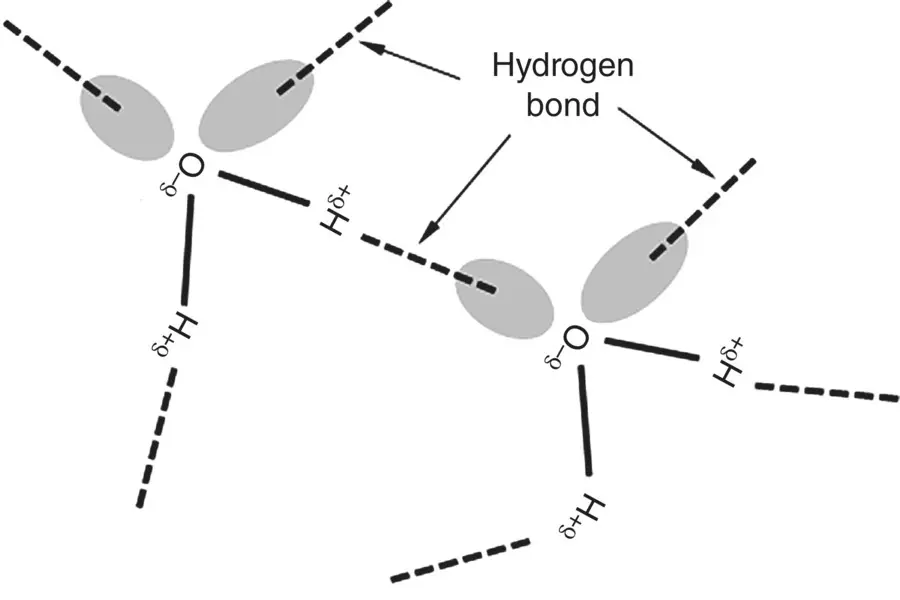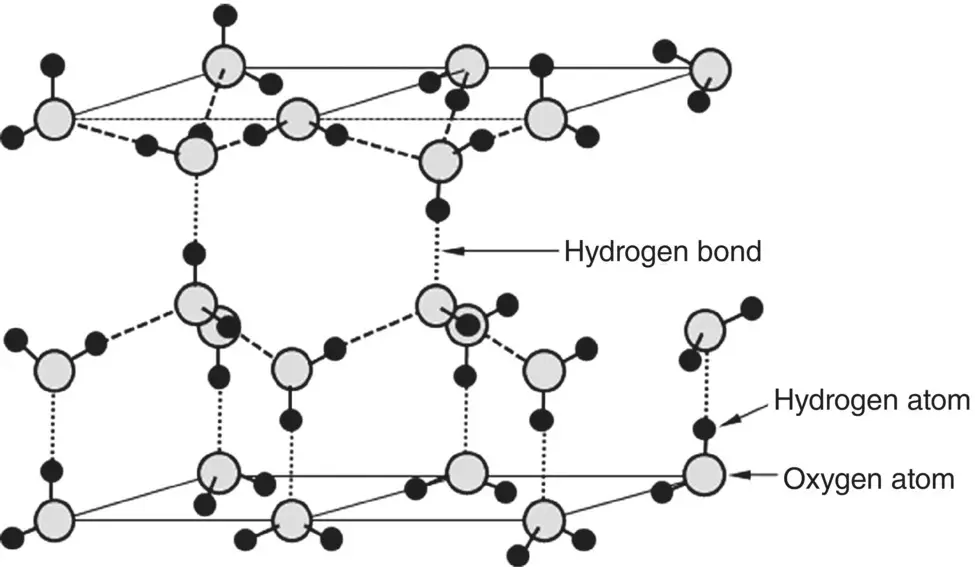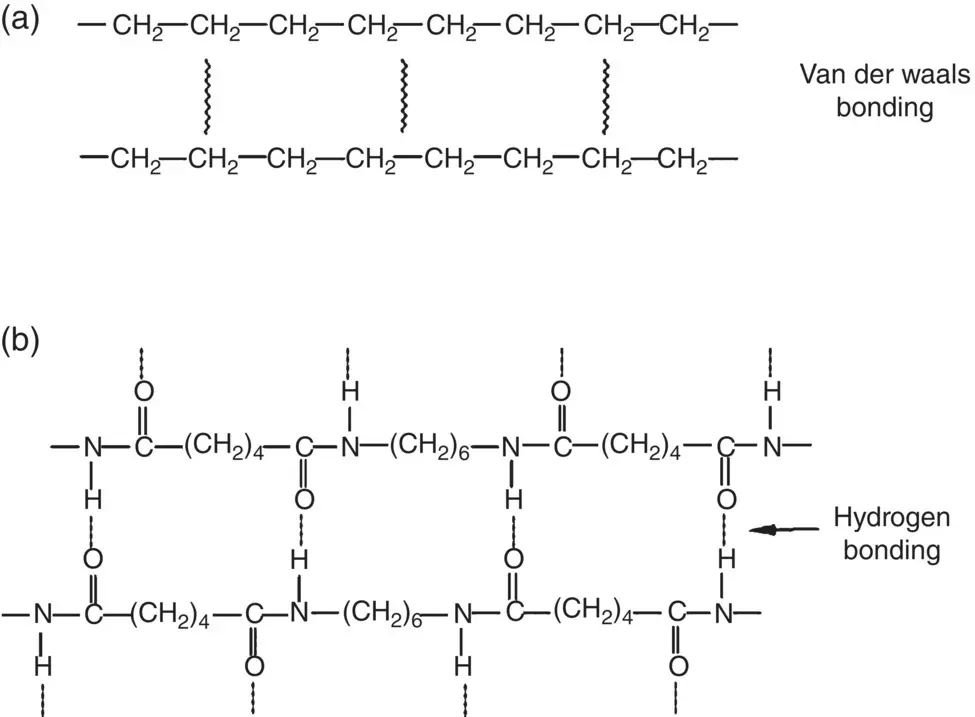Dispersion forces, sometimes referred to as London forces, are the type of force that exists between nonpolar atoms such as argon, or between nonpolar molecules such as nitrogen. To see how this type of attractive force arises, we will consider the argon atom ( Figure 2.12a). Although the argon atom (Atom 1) has a symmetrical distribution of electrons surrounding its nucleus so that is has no dipole, this situation is only true as an average over time. At any instant, the electron cloud undergoes local fluctuations in charge density, making the argon atom an instantaneous dipole. This instantaneous dipole produces an electric field that polarizes the electron distribution in a neighboring argon atom (Atom 2), so that the neighboring atom itself acquires a dipole. The electrostatic interaction between these two dipoles leads to an attractive force.
Debye forces, sometimes described as dipole‐induced dipole forces: In this type of force, a polar molecule such as hydrogen chloride (HCl), for example, can induce a dipole in a neighboring nonpolar atom or molecule, such as an argon atom, for example, which results in an attractive electrostatic force between them ( Figure 2.12b).
Keesom forces, sometimes described as dipole–dipole forces: A polar molecule such as HCl, for example, can interact electrostatically with another polar molecule, such as HCl, to produce an attractive force ( Figure 2.12c).

Figure 2.12 Illustration of the interactions in van der Waals bonding: (a) dispersion force between nonpolar atoms or molecules; (b) Debye force between a polar molecule with a permanent dipole moment and a nonpolar atom or molecule; (c) Keesom force between two polar molecules, each having a permanent dipole moment.
The attractive force between two dipoles can be calculated from Coulomb’s law of electrostatics. A simple case is the force between two parallel dipoles, that is, when their dipole moment is in the same direction, as illustrated in Figure 2.12. A dipole of charge magnitude δq and distance of separation r between its ends has a dipole moment given by
(2.6) 
The attractive force between two parallel dipoles of moment p 1and p 2, respectively, separated by a distance x that is much larger than r , is
(2.7) 
where, ε ois the permittivity of free space. According to Eq. (2.7), the attractive force is equal to the product of the two dipole moments and inversely proportional to the fourth power of their separation distance. The larger the dipole moments, the larger the attractive force.
Keesom forces between permanent dipoles typically provide the strongest van der Waals attraction whereas dispersion forces provide the weakest. Figure 2.13shows an illustration of the structure of trichloromethane (CHCl 3), a molecule with a permanent dipole due to the difference in electronegativity of the atoms in the molecule. In comparison, the tetrachloromethane molecule (CCl 4), where the H in CHCl 3is replaced with Cl, is nonpolar because there is no net dipole moment.

Figure 2.13 Illustration of (a) polarity of each covalent bond in the trichloromethane molecule (CHCl 3), and (b) overall net dipole of the molecule.
Although much weaker than the primary bonds, hydrogen bonds are a strong type of intermolecular bonding ( Table 2.2). Hydrogen bonds result from Keesom forces, the bonding between molecules that have a permanent dipole, but in addition they have the following characteristics:
A hydrogen atom is covalently bonded to a highly electronegative atom, thus the hydrogen atom has a slight positive character while the highly electronegative atom has a slight negative character.
The highly electronegative atom to which the hydrogen atom is bonded has at least one active set of lone pair electrons.
A well‐known example of hydrogen bonding is between H 2O molecules in water ( Figure 2.14). By sharing one electron in its outer shell with each hydrogen atom, the oxygen atom achieves an outer shell containing eight electrons, but the four unshared electrons make up two orbitals, each containing two electrons. The two unshared electrons in each orbital are referred to as lone pair electrons. The hydrogen bond involves intermolecular bonding between a hydrogen atom of one molecule and a lone pair electron in the oxygen atom of a neighboring molecule. When water freezes, the tetrahedral arrangement of sp 3orbitals of the oxygen atom coupled with hydrogen bonding between the water molecules results in an ordered three‐dimensional pattern of the molecules in ice ( Figure 2.15). The hydrogen bonds keep the molecules well apart, which is why ice has a lower density than water.

Figure 2.14 Schematic illustration of hydrogen bonds between water molecules.

Figure 2.15 Illustration of the arrangement of water (H 2O) molecules in ice showing the hydrogen bonds.
Secondary bonds also play an important role in polymers, providing links between their constituent macromolecules that make them solids at ordinary temperatures. In polyethylene composed of nonpolar macromolecules, secondary bonding consists of weak van der Waals bonds ( Figure 2.16a). On the other hand, polymers composed of macromolecules that have polar groups, such as OH and NH groups, form stronger hydrogen bonds. When the macromolecules of the synthetic polymer nylon 6.6 are aligned in the formation of fibers, hydrogen bonding between carbonyl oxygen and amide hydrogen atoms of neighboring molecules serve to stabilize the structure, thus contributing to the high mechanical properties of the fibers ( Figure 2.16b).

Figure 2.16 Schematic comparison of (a) van der Waals bonding between nonpolar polyethylene macromolecules and (b) hydrogen bonding between polar nylon 6.6 macromolecules.
2.6 Atomic Bonding and Structure in Proteins
Proteins are the most versatile macromolecules in living organisms and they serve crucial functions in essentially all biological processes (Alberts et al. 2014). They are not only long‐chain molecules but they can fold in a complex manner to give a variety of three‐dimensional shapes. The functionality of a protein depends critically on its conformation and, thus, an understanding of how atomic bonding controls the overall three‐dimensional shape of a protein is important. Because of its complexity, the conformation of proteins is often described at multiple levels, referred to as primary, secondary, tertiary, and quaternary structure, each emphasizing different features of the overall three‐dimensional structure.
Читать дальше



















